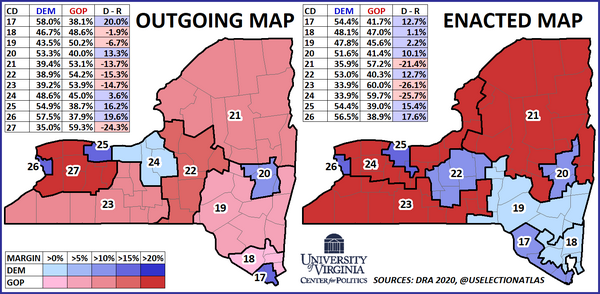Senior elections analyst Nathaniel Rakich breaks down how New York state was able to pass its Democratically gerrymandered congressional map and what it could mean for the 2022 midterm race.Larry Sabato's Crystal Ball at the University of Virginia Center for Politics had its own analysis as part of Democrats’ Position Improves in Redistricting Tally by Kyle Kondik and J. Miles Coleman.
Democrats enacted an aggressive gerrymander of their own in New York, which we will analyze in some depth below.Hearing Andrew Rakich and reading Kondik and Coleman makes me glad that Michigan's independent redistricting commission was able to agree on its maps for the state's legislative and Congressional districts. At least that part of the reform has worked so far, but I'm not celebrating until the maps survive all the court challenges they face.
...
Though New York had a newly-formed independent commission to oversee the line drawing this cycle, the legislature retained the power to draw the lines itself. As expected, Democratic legislators ended up doing just that, and Gov. Kathy Hochul (D-NY) made good on her earlier suggestion that she’d use the redistricting process to boost her party’s prospects.
Hochul’s approach is a departure from that of her predecessor, former Democratic Gov. Andrew Cuomo. A decade ago, he seemed intent on taking the high road, and publicly decried gerrymandering — Republicans also still controlled the state Senate back then, meaning that neither side could dominate the process. As a result, New York ended up going with a court-drawn map for the decade. But this round, New York supplanted Illinois as the largest state where Democrats had a free hand in drawing a map, although some Republicans may complain that California’s independent commission made consistently pro-Democratic choices.
While New York lost a district — had it counted just 89 more residents in the last census, it would have retained all its seats — Democrats seem likely to come out ahead. If the Democratic plan pans out as intended, the number of Republicans in the New York delegation will shrink from 8 of 27 to 4 of 26.
Also, it shows how important the U.S. Census is. Just 89 more New Yorkers to retain a Congressional seat? Yikes!
Follow over the jump for more from Sabato's Crystal Ball along with my commentary.
The article examines Congressional districts in the New York City area in some detail, which FiveThirtyEight's video shows, albeit briefly, as examples of non-compactness. It didn't focus as much attention on Upstate New York, but Kondik and Coleman did.
Moving to Upstate New York, Democrats made several key changes aimed at bolstering their prospects.
Map 1 compares the Upstate districts on the outgoing map to those on the recently-enacted map. Though there has been some debate among geography buffs and locals as to where the region starts, for our purposes, we’re defining the “Upstate” districts as those that are located entirely north of New York City. Additionally, as Hillary Clinton performed a bit worse than Biden throughout the region, we’re using the 2016 presidential numbers, which are less rosy for Democrats than 2020’s, as a baseline for Map 1.

On the outgoing map, Trump carried 6 districts to Clinton’s 5 — that balance become 7-3 in Clinton’s favor on the new map. The 3 remaining Trump-won seats are also, collectively, considerably safer: There are no marginal Trump seats on the new map, as he carried all 3 by over 20 points.On the one hand, this is bad news for Republicans overall, but it's good news for the survivors of the process and one Representative in particular.
Rep. Elise Stefanik (R, NY-21) retains a North Country seat that, geographically, sits atop the state. Though this area was competitive a decade ago — if it was in place in 2012, it would have likely been a rare McCain-to-Obama seat — it swung sharply rightward in the Trump era.Looks like I'll have plenty of opportunities to use the Little Slurmaid label during the rest of this decade. I don't know if I like that or not.
Kondik and Coleman closed their analysis of New York's gerrymander with the same conclusion that FiveThirtyEight came to.
Ideally for Democrats, the map they gerrymandered for themselves would produce a 22-4 statewide edge, up substantially from the 19-8 advantage they hold now. However, our ratings suggest they will have to work to actually realize this advantage in 2022 if indeed there is a Republican-leaning political environment.I don't think anything will happen to New York's new districts, either. As a Democrat, I like this. As a progressive who wants good government, I'm not thrilled.
In drawing this gerrymander, aside from ignoring the independent redistricting commission that voters created in 2014, Democrats were also were able to muster 2/3rds supermajorities to enact the gerrymander after voters rejected an effort to ease their path to a gerrymander in last year’s November elections.
However, the 2014 constitutional amendment did add language to the state constitution stating that districts should be “as compact in form as practicable” and “shall not be drawn to discourage competition or for the purpose of favoring or disfavoring incumbents or other particular candidates or political parties.” Republicans certainly can make a credible argument that this map violates those principles. Rep. Jerrold Nadler’s NY-10 — which uses a thin strip of precincts to connect dark blue parts of Manhattan to Republican-leaning Orthodox Jewish neighborhoods of Brooklyn — has emerged as a prime point of contention. Whether the courts ultimately agree is unknown: All 7 members of the state’s highest court, the New York Court of Appeals, were appointed by Democratic governors.
Enough politics. Tomorrow is World Pangolin Day. Stay tuned to see if I actually celebrate it.
No comments:
Post a Comment